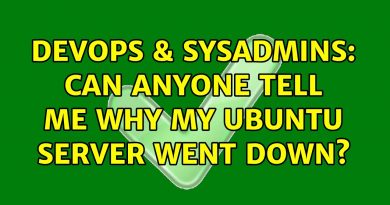Creating hard and soft links in Linux – LFCS – Linux Foundation Certified System Administrator 2020
This lecture is part of my full course on LFCS, Linux certified systems administrator, located here:
https://mylinuxgig.thinkific.com/courses/lfcs
Essential Commands – 25%
⦁ Log into local & remote graphical and text mode consoles
⦁ Search for files
⦁ Evaluate and compare the basic file system features and options
⦁ Compare and manipulate file content
⦁ Use input-output redirection
⦁ Analyze text using basic regular expressions
⦁ Archive, backup, compress, unpack, and uncompress files
⦁ Create, delete, copy, and move files and directories
⦁ Create and manage hard and soft links
⦁ List, set, and change standard file permissions
⦁ Read, and use system documentation
⦁ Manage access to the root account
Operation of Running Systems – 20%
⦁ Boot, reboot, and shut down a system safely
⦁ Boot or change system into different operating modes
⦁ Install, configure and troubleshoot bootloaders
⦁ Diagnose and manage processes
⦁ Locate and analyze system log files
⦁ Schedule tasks to run at a set date and time
⦁ Verify completion of scheduled jobs
⦁ Update software to provide required functionality and security
⦁ Verify the integrity and availability of resources
⦁ Verify the integrity and availability of key processes
⦁ Change kernel runtime parameters, persistent and non-persistent
⦁ Use scripting to automate system maintenance tasks
⦁ Manage the startup process and services (In Services Configuration)
⦁ List and identify SELinux/AppArmor file and process contexts
⦁ Manage Software
⦁ Identify the component of a Linux distribution that a file belongs to
User and Group Management – 10%
⦁ Create, delete, and modify local user accounts
⦁ Create, delete, and modify local groups and group memberships
⦁ Manage system-wide environment profiles
⦁ Manage template user environment
⦁ Configure user resource limits
⦁ Manage user privileges
⦁ Configure PAM
Networking – 12%
⦁ Configure networking and hostname resolution statically or dynamically
⦁ Configure network services to start automatically at boot
⦁ Implement packet filtering
⦁ Start, stop, and check the status of network services
⦁ Statically route IP traffic
⦁ Synchronize time using other network peers
Service Configuration – 20%
⦁ Configure a caching DNS server
⦁ Maintain a DNS zone
⦁ Configure email aliases
⦁ Configure SSH servers and clients
⦁ Restrict access to the HTTP proxy server
⦁ Configure an IMAP and IMAPS service
⦁ Query and modify the behavior of system services at various operating modes
⦁ Configure an HTTP server
⦁ Configure HTTP server log files
⦁ Configure a database server
⦁ Restrict access to a web page
⦁ Manage and configure containers
⦁ Manage and configure Virtual Machines
Storage Management – 13%
⦁ List, create, delete, and modify physical storage partitions
⦁ Manage and configure LVM storage
⦁ Create and configure encrypted storage
⦁ Configure systems to mount file systems at or during boot
⦁ Configure and manage swap space
⦁ Create and manage RAID devices
⦁ Configure systems to mount file systems on demand
⦁ Create, manage and diagnose advanced file system permissions
⦁ Setup user and group disk quotas for filesystems
⦁ Create and configure file systems
by Javed Akbar
linux foundation


